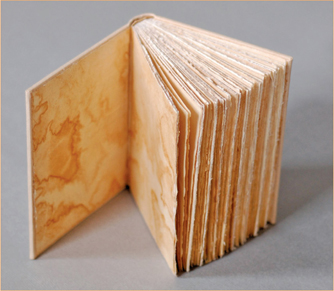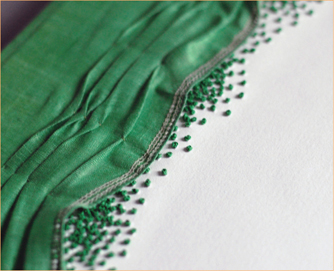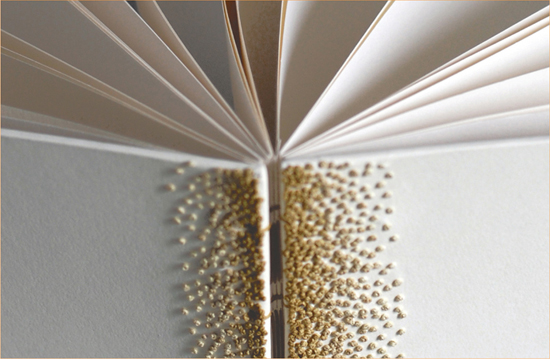

Throughout this chapter we look at the different ways in which bookmakers treat the inside pages and covers of their books. From experimenting with food dyes to marbling and hand stamping, the ways in which they work to change and manipulate the materials they use is varied. Some techniques are more complex than others, but all have the same result which is to add either character, texture, or color to the handmade books.
New York-based artist Natalie Stopka’s work is material driven, and in this chapter we look at her plant-dyed linen book covers as well as her hand-stitched embellishments. We also look at Ruth Bleakley’s marbled covers and Lotta Hellberg’s eco-printed and indigo-dyed covers. These and other contemporary examples showcase the beautiful results that can be achieved with each technique.

Anna Fewster runs a small press producing limited-edition literary material on an Adana Eight-Five letterpress printer from a cottage on the east Kent coast in the UK. Her focus is on texture and color.
“I like to create work that expresses and reflects my love of design and detail, and that inspires an appreciation of the characteristic texture and quality of letterpress.”
Fewster has used marbling to bring color and texture to this book cover. She experimented for some weeks before settling on the right colors and look. “Marbling has a lovely loose spontaneity to it, and each cover is completely unique.” Fewster uses watercolors floated in carrageenan to create the marbled effect, which is a messy, traditional method that yields very vivid results.
Fewster used off-white Zerkall mold-made 145gsm stock for the inside pages, which were letterpress printed, and a smooth Somerset 200gsm for the cover, as clear and clean marbling needs a smooth surface. The book was then bound using pamphlet stitch with linen thread.
See also:
Pamphlet stitch
Suminagashi paper marbling
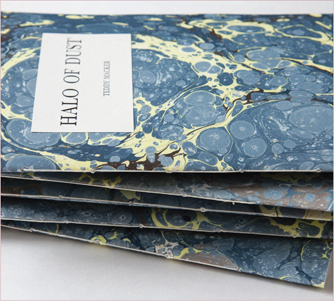


Alice Fox is a visual artist working in textiles and printmaking, taking much of her inspiration from the natural world. With a previous career in conservation, Fox aims to use sustainable processes in her work to celebrate the natural world, while at the same time having minimum impact upon it.
“I work with paper, linen, silk, and wool. I often treat paper as a textile, stitching into it and dyeing it in the same way I would a piece of fabric.”
The series “Tide Marks” shown here was inspired by coastal landscapes and serves as a record of Fox’s beach walks. To create the effect on the pages in the books, Fox first used tea to stain the paper, then soaked it, before making collagraph prints using a printing press and plates made with found items. Fabriano Rosaspina paper was used for the inside pages as it can withstand the fairly deep embossing from the collagraph print. Gray boards covered in cotton bookbinding cloth have been used for the covers.
“These books are records of my walks on the beach. They can be seen as snapshots of moments, textures, and marks from the beach captured in a linear form.”
See also:
Accordion book
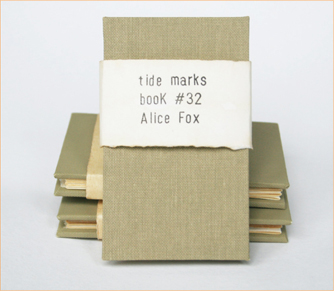
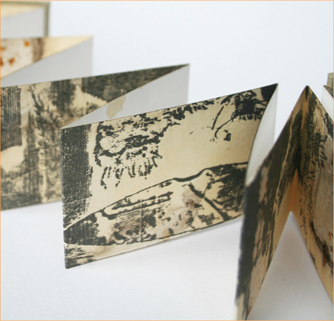

Nourish, All Our Relations, by Diane Jacobs of Scantron Press, celebrates the wonders of our natural and man-made world. Beneath the beauty, however, lies an environmental time bomb of catastrophic proportions. Through seduction and metaphor, Jacobs weaves layered imagery to awaken a sense of urgency. It is an unbound artist book composed of eight twice-folded folios, printed on both sides, and housed in a hand-crafted collapsible bamboo box. She mapped out 15 different multicolor reduction relief prints, printed polymer plates made from drawings, and utilized pressure-printing methods. The pages have endured over 100 runs through a Vandercook letterpress.
While working on Nourish, Jacobs discovered that transparent paper introduces an element of artistic chance. As light shines through a page, layers of color and image become more than the sum of their parts; they reveal new meanings. The papers used were Gampi-shi, two-layer Gampi, and Usuyo Gampi. The bamboo box contains a porcelain wishbone and a cast paper pulp spoon, sewn onto wool felt.
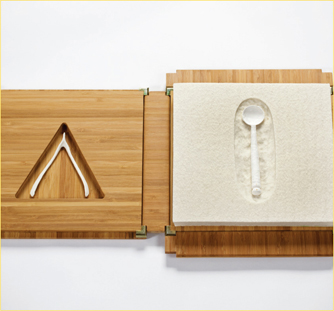
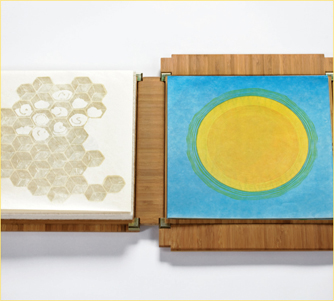


Serena Olivieri is an Italian illustrator now based in Madrid, Spain. She is a self-taught bookmaker with a passion for pattern design who always likes to experiment with new techniques. Her handmade notebooks feature plenty of patterns, color cutouts, and pop-ups. “I love the process involved in making these books. Each time I start a new book I find a way to make something different within it. I also love to go to the paper shop and to choose between the different textures of paper.”
Flores features hand-drawn illustrations on the cover, the edges of which have been cut out. “I wanted to create a decoration for the cover so began by drawing flowers. I wasn’t convinced though, so decided to cut out pieces from the edge.” This book has been Italian bound, another simple sewn binding.
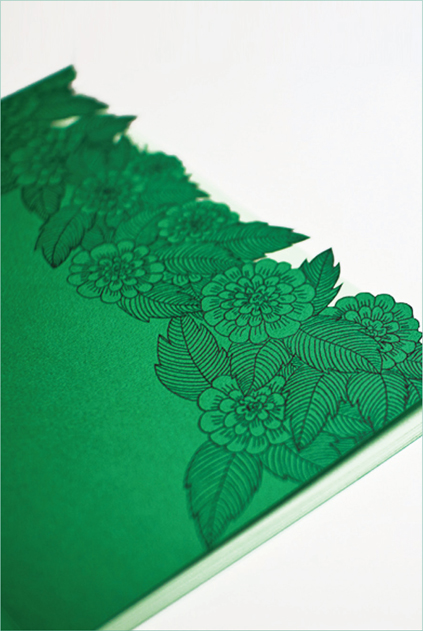

Anneke De Clerck, has created this set of six books that all incorporate hand-stamping on the cover.
“I found this photorealistic rose stamp by Darkroom Door and when I started stamping with it to find the right color the idea was born to make a series of six books.” The result is a set of six different colored stamped books that sit inside a handmade box. De Clerck has used a Coptic stitch to bind the books as it allows them to lie flat when open. “I love this stitch, I used it to make my first book. It is great because as it lies flat when open it makes it easier to paint, draw, and write in the book.”
De Clerck used a cream colored medium-weight smooth paper for the covers and a handmade paper to cover the box.
See also:
Coptic stitch

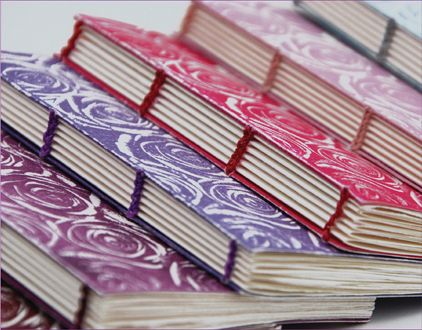

Specializing in embroidered covers, Cathy Durso is a Boston-based artist and bookbinder who makes hand-bound journals, sketchbooks, portfolio cases, and keepsake boxes. She creates custom-made books and box covers featuring embroidered images, monograms, names, dates, and phrases, among others.
“My main clients are artists looking for a custom portfolio case, as well as people looking to give a special keepsake gift to an artist or writer. I enjoy the duality of creativity and meticulous attention to detail that bookbinding requires, and I really love transforming my customers’ ideas into a finished product that they love and treasure.”
Largely inspired by science and nature, Durso draws out a design on the reverse side of her cloth, which she uses as a guide for the stitching. After the design is stitched onto the cloth, the cloth is glued to the book board. For closed-spine books she uses traditional Western-style multi-signature binding for its strength and durability—ideal for books that get a lot of use, such as journals and sketchbooks.
See also:
Book cloth
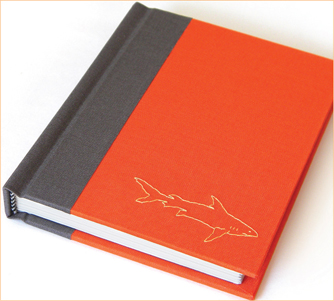
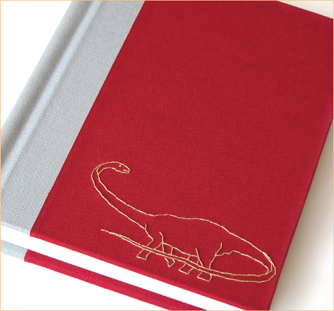


Inayza is the studio name of Cairo-based artist and designer Gina Nagi. She is experimental in her work, as can be seen here with these cover designs.
The embroidered book was created for a Christmas bazaar and sees the stitches follow on to the cover from the Coptic stitch spine. Nagi punched 1/12" (2mm) holes into the cover first so she could then stitch through them using linen thread.
For the hand-printed cover, Nagi created patterns using vegetable stamps made from potatoes, carrots, and capsicums, as well as old candy bar wrappers. The simple pamphlet-sewn notebook uses Canson paper stock for the cover.
The marbled cover was created for a client who was particulary interested in marbling. Nagi teamed the traditional, old-style marbling technique with a brightly colored modern cloth on the spine. The book was stitched using linen thread, gauze, and craft paper, and features a sewing band to strengthen the spine.
See also:
Coptic stitch
Pamphlet stitch
Suminagashi paper marbling

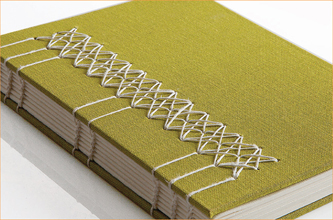
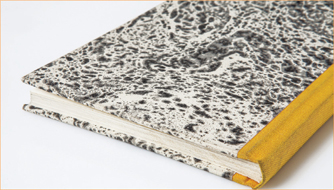

Based in Quzhou, a small city in eastern China, self-taught bookbinder Hu Jin runs H&G Handmade.
Jin designs her own patterns, which she then prints onto book cloth. The pattern designs are based on a variety of inspirations, but particularly trees and flowers. “Nature always inspires me. The patterns I create take me back to certain places, like lying on the grass, hearing the sounds of leaves and branches swaying in the wind above me.”
Jin has screenprinted each of these covers by hand. The linen cloth is then fixed to book board and assembled with the signatures before being bound together. Jin uses Coptic stitch, “a simple and elegant binding that allows the patterns on the cover to be completely visible. I think the cover and the stitch also complement each other really well.”
See also:
Book cloth
Coptic stitch

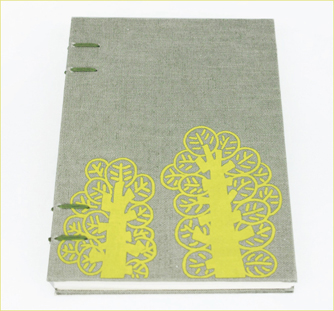

Tara Hogan, the founder of INK+WIT, is a graphic designer and illustrator who specializes in brand identity, stationery design, and limited-edition printing. She favors working with letterpress, wood veneer, and screenprinting, and likes to experiment with materials and textures.
This book was created as a personal project dedicated to her grandfather and his love of the outdoors and nature. Hogan carried out extensive photo research and scanned images into Adobe Illustrator to create a collage and add type. She also researched different papers and textures.
The book was bound using pamphlet stitch with a natural embroidery thread. “The bookmaking process has so many layers,” Hogan explains. “Your appreciation for books is heightened when you see how much work is involved precision-wise and time-wise.”
See also:
Pamphlet stitch
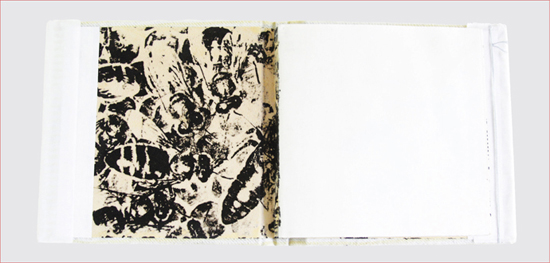

Born in Sweden, Lotta Helleberg is a textile artist, printmaker, and self-taught book artist. She uses hand-printed and hand-dyed fabrics as a base for quilts, collages, and other objects.
“I love how handmade books can tell a story, without always using a lot of words. I have always loved making work that is both beautiful and useful, and that is how these small notebooks came to be.”
These notebooks feature eco-printed and indigo-dyed covers. Eco-printing is achieved by layering paper (or fabric) with plants, then either rolling or clamping them tight, and exposing them to simmering water or steam. Indigo dyeing is another natural dye method, but is faster as it simply involves dipping paper in an indigo vat several times to create subtle color variations and lines.
See also:
Natural plant dyeing
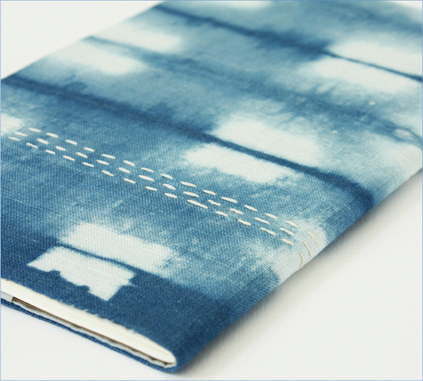


RAMA is a group of graphic designers based in Buenos Aires specializing in bookbinding and letterpress printing. Their focus is on color, typography, and experimenting with different materials. Their work often features different kinds of papers, cardboards, and fabrics, as well as various recycled materials including old magazines and newspapers, plastics, and wood.
Shown here is their case-bound notebook Rainy Days, a one-of-a-kind book made using Bookcel 80gsm stock for the inner pages, Fabriano 120gsm stock for the endpapers, and ⅛" (3mm) cardboard for the cover. The cover has been finished with white bookbinding cloth that has been hand-painted with both fabric paint and acrylics.
See also:
Book cloth

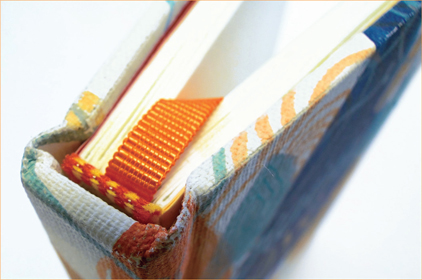

Ruth Bleakley is a Florida-based designer, book artist, and teacher. As well as Coptic-bound books, she also specializes in marbled paper.
“Marbling is a very old method of decorating paper using floating inks or paints on a liquid surface. By laying a sheet of paper on top of these floating inks and pulling a one-time print off the surface, you have your marbled paper.”
Bleakley’s favored marbling technique is the Japanese technique of floating black Sumi-E ink on water to create designs that look like woodgrain, with thick alternating black and white rings. Once dry Bleakley uses the marbled papers to cover her Coptic-bound books. She also creates marbled papers using colored inks.
See also:
Coptic stitch
Suminagashi paper marbling
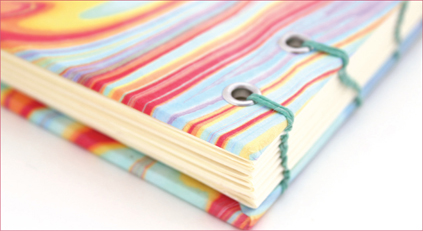
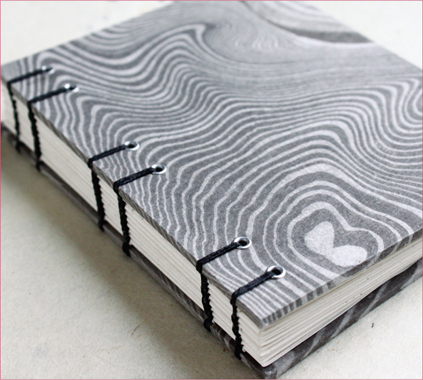

Katie Taylor Frisch of Feeding the Lake is a fiber artist and bookbinder working primarily with felted wools and handmade paper. She uses a range of techniques to create cover material for her hand-bound books. The cover shown here was created with fiber-reactive dyes, which are synthetic dyes that actually bond with fiber. She also uses linen fabrics which she block-prints, and she works with handmade pigmented cotton paper stocks. The interior pages of her books are either handmade recycled stocks or 80 Neenah Environment stock.
“I create my books and journals out of my love for textiles. I also love creating books, beautiful vessels for the recording of wisdom and experiences.”
See also:
Book cloth
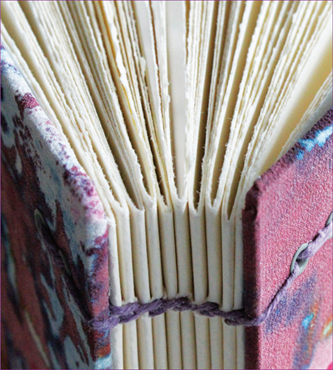
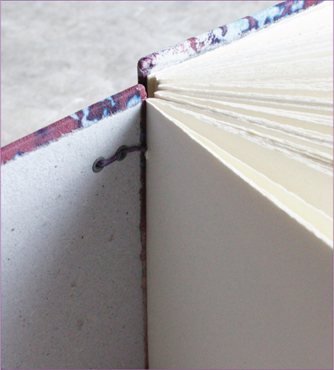

Originally from Canada but now based in Berlin, Germany, Leah Buckareff is a bookbinder who primarily creates case-bound books, but also likes to print, paint, and embroider her designs onto the cloth she uses to cover her books.
“I generally find inspiration in my travels (abstract landscapes) or in the particular paper or cloth I’ll be using. This makes each of my books ‘one of a kind’ … I will repeat motifs, but the characteristics of the material and fact it’s all completely handmade means that no two books are exactly alike.”
Little Trees features a linen cloth cover embroidered with small pine trees. Buckareff used an accordion-fold binding to create the book, with the pages made using acid-free Canson paper.
I Used to be Wood is a pamphlet-stitched book that features Buckareff’s embroidery. Inspired by the woodgrain paper she used for the cover, the journals have a message: “I wanted people who consume books and journals to remember where the material they are made with comes from, and consider this. I guess I’m sharing my guilt with a little humor.” Buckareff has painted the paper edges of the book with watercolors that match the color of the threads used in the cover embroideries.
See also:
Pamphlet stitch
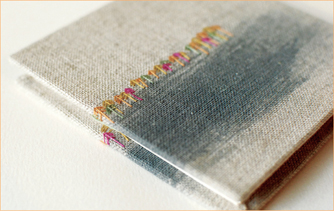
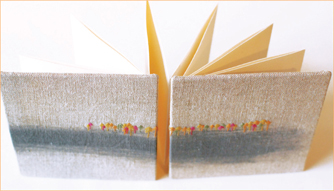
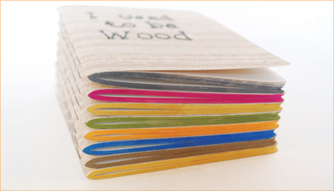

Designer Jen Shaffer of Painted Fish Studio created these two hand-punched books in her home studio in Minnesota. Both book covers are created using cloth-covered board; Shaffer then uses a book drill to punch the letters into the covers based on a paper template she creates. An interior cover sheet is then glued to the boards, and, after drying, the inside signatures are either glued or bound to the covers, depending on the book type.
“Paper is my favorite material to work with, but I’m always looking for ways to make it unique. I like to use unexpected embellishments or color combinations. Sometimes I wonder if my love of bookbinding is an excuse to justify buying the lovely papers I find.”
For the book Hi she has used matte board and pink book cloth for the cover, and then Arches watercolor paper for the inside pages. The cover of Hello is made with matte board covered with off-white book cloth, and the inside pages are French’s Dur-O-Tone Newsprint Extra White.
See also:
Book cloth

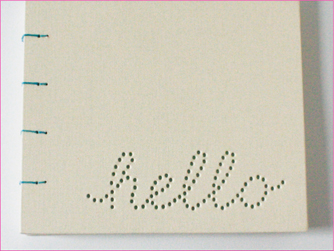

Emma Bonsall is an English crafter and maker based in Canada. She specializes in making arts and crafts from recycled materials. Her favored materials for decorative bookmaking are vintage atlases, geography textbooks, tourist maps, and old subway maps. “Discarded maps have such a beauty of shape and color and history to them that I am constantly rescuing them. Being able to take a basic notebook and turn it into something desirable using recycled materials seems the perfect fit for me.”
The Atlas cover was created with recycled pages from a 1970s National Geographic atlas, woven together to create a “fabric,” that was then adhered to the book cover. The pattern-covered books have been created using recycled security envelopes. Bonsall cut, folded, and played with the security papers, separating out the colors and patterns, and finding complementary designs to work with.
“There are so many different color and pattern combinations with security envelopes, commonly geometric designs that lend themselves so well to modern creative works. I love the idea of people saving and using their own security envelopes, a plentiful, free source of decorative papers given to everyone.”
See also:
Woven cover

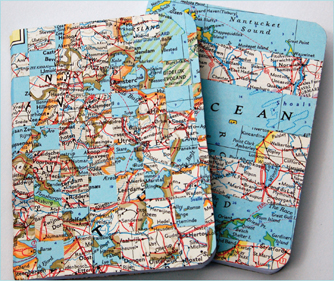

Marjolein Coenrady is a graphic designer from the Netherlands with a passion for book design, bookbinding, paper, and typography. She created these books to have a handmade, unique look on the outside, and to be functional on the inside—ruled pages for the notebooks, blank paper for the sketchbook. The covers of these books feature images created from dried plants that she found in her mother’s old school books.
“The plant specimens I found in the old books were stunning; so carefully preserved with old pieces of tape that had turned sepia in color with age. I scanned the best pages and made a series of paper goods out of them, which I then used on the covers of these notebooks.”
Coenrady’s books have linen spines, and in the case of the sketchbook, a ribbon closure. The pages of the sketchbook are glued together so it is possible for the user to easily tear out their sketches.
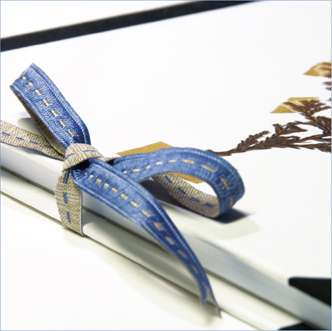


AG&P Handmade is run by freelance graphic designer Rima Bueno who uses bookbinding as a way of getting away from the computer and utilizing her creativity.
“I like to follow things that interest me and have fun with them. With bookbinding I really wanted to make something useful out of the excess paper samples and supplies that have accumulated from my print work. I love playing with paper and materials, looking at their properties, and pulling together different colors and textures.”
Bueno’s Unryu paper case-bound books feature a number of different leftover papers with varying textures and colors. These Unryu papers are soft, cloth-like papers that also have varied translucence. The cases were covered with colored papers first, so the Unryu papers wouldn’t be dulled down by the brown boards showing through.
See also:
Case binding

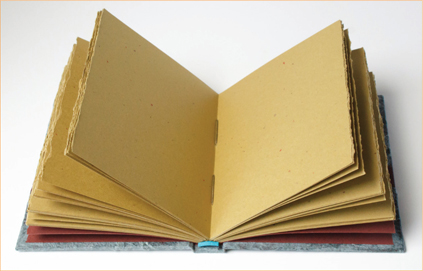

Based in North London, Harrington & Squires is run by designers and printers Chrissie Charlton and Vicky Fullick. Together they create bespoke design and letterpress prints, products, and limited-edition books, as well as run workshops where they teach typography, typesetting, and letterpress printing.
Shown here are two of their handmade books, The Jealous Sole and In Art. Both books feature pierced and punched inner pages. For The Jealous Sole, Charlton and Fullick worked into the pages of the book using various perforators, cutters, and hole punchers to add another dimension to the surface of the paper. Similarly for In Art, the surface of the paper was worked into using a Japanese screw punch, punching lines of holes to connect the type and add another element to the illustration. Both books were bound by hand in a ‘Singer sewing’ style.
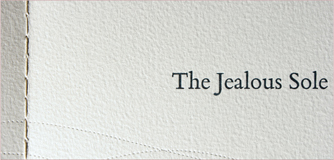
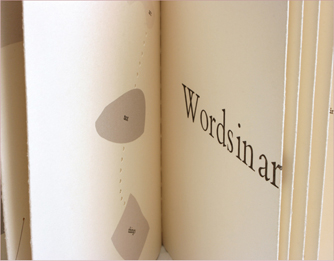
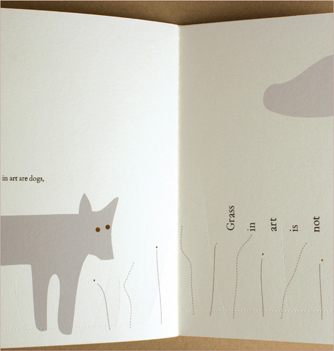

Kaija Rantakari is a bookbinder and artist based in Jyväskylä, Finland. Many of her books feature Coptic binding. “I love the simplicity of the structure, how it’s stripped down to the mere essentials. It’s easy to combine this simple structure with simple, stylish materials.”
Rantakari is particularly keen on using fabric covers, which she adorns with vintage finds or embroidery. She tends to begin the creative process by finding materials that inspire her before then going ahead designing and creating a book. The books included here feature pieces of delicate lace material, linen fabric, and antique brass disks on the covers.
“More often than not I use linen as my covering material; it’s a beautiful fabric on its own, but it’s also a wonderful background for all sorts of things, like vintage bits and bobs, or embroidery. I like how linen gives a book an ageless look that can be manipulated into the direction of modern as well as the style of some long-gone era.”
See also:
Book cloth
Coptic stitch



New York-based Natalie Stopka would describe herself as a book artist focused on unconventional structure, textiles, and tactility. “My work is very materials-driven, and so I enjoy the exploratory process at the beginning of a project. I focus on working with uncommon fibers, repurposed and hand-dyed fabrics, and vintage textiles. This can include everything from dyeing and eco-printing to weaving and embroidery.”
The linen cover, pages, binding thread, and silk headbands of each of these case-bound books have been naturally dyed with plant materials. Each of these fibers takes the same dye in a distinctly different shade, showing the range of different colors that can be achieved from dyeing different materials with the same plant. The dye from the plants is extracted by soaking or simmering. Each of the elements of the books are then mordanted with alum to assist the dye in bonding to the fabric and paper fibers. The fabric and papers are then submerged in the dye bath for at least 24 hours. Once rinsed and dried they are ready for binding.
Stopka’s other covers feature not only embroidery techniques but also sculpted fabric, that is sewn into place by hand using French knot stitches.
See also:
Natural plant dyeing
